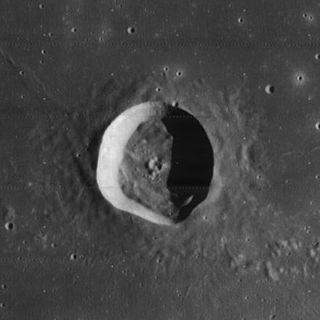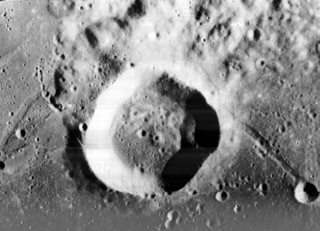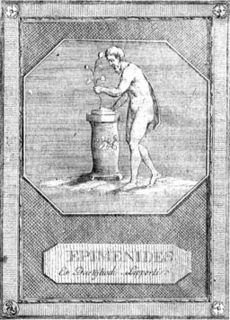
Euclides is a small lunar impact crater located near the eastern edge of Oceanus Procellarum, about 30 kilometers to the west of the Montes Riphaeus mountains. The mare in the vicinity is devoid of significant craters, but to the west is an area of low rises. The crater is named after the Greek mathematician Euclid.

Fauth is a small double-crater located at the edge of the rough southern ramparts of the prominent ray crater Copernicus on the Moon. It lies in the Mare Insularum, to the northeast of the crater Reinhold. The crater is named after German selenographer Philipp Johann Heinrich Fauth.

Atlas is a prominent lunar impact crater that is located in the northeast part of the Moon, to the southeast of Mare Frigoris. Just to the west is the slightly smaller but still prominent crater Hercules. Northeast of Atlas is the large Endymion.

Flamsteed is a small lunar impact crater located on the Oceanus Procellarum, which is named after British astronomer John Flamsteed. It lies almost due east of the dark-hued Grimaldi, and north-northwest of the flooded Letronne bay on the south edge of the mare.

Herschel is a lunar impact crater located just to the north of the walled plain Ptolemaeus. Its diameter is 39 km. It was named after German-born British astronomer William Herschel.

Aliacensis is a lunar impact crater that is located in the rugged southern highlands of the Moon. The crater Werner is located just to its north-northwest, and a narrow, rugged valley lies between the two comparably sized formations. To the southwest is Walther, and Apianus is to the northeast. Aliacensis is named after the 14th century French geographer and theologian Pierre d'Ailly. It is from the Nectarian period, which lasted from 3.92 to 3.85 billion years ago.

Gruithuisen is a lunar impact crater that lies on the section of lunar mare that joins Oceanus Procellarum in the west to Mare Imbrium in the east. Southeast of Gruithuisen is the small crater Delisle. To the south is Dorsum Bucher, a wrinkle ridge running in a north–south direction for about 90 kilometers.

Balboa is a lunar impact crater that is located near the western limb of the Moon. Due to foreshortening, the crater appears highly oval when viewed from the Earth. In actuality, however, the formation is relatively circular. It is comparable in size to the crater Dalton, located just to the southwest. The eastern rim of Balboa lies just to the west of the Oceanus Procellarum.

Ellison is a lunar impact crater that lies on the far side of the Moon from the Earth. It is located just beyond the northwest limb of the Moon, to the southwest of the large walled plain Poczobutt. Due west of Ellison is the crater Coulomb.

Deluc is a lunar impact crater that lies in the southern highlands of the Moon. It is located to the south-southeast of the crater Maginus, and the huge Clavius. Due east of Deluc is the somewhat larger crater Lilius. It is 47 kilometers in diameter and 3.3 kilometers deep. It is from the Pre-Imbrian period, which lasted from 4.55 to 3.85 billion years ago.

Damoiseau is a lunar impact crater that is located just to the west of the Oceanus Procellarum, in the western part of the Moon's near side. It lies due east of the prominent crater Grimaldi, a walled plain with a distinctive dark floor. Due south of Damoiseau is the crater Sirsalis.

Cori is a lunar impact crater that is located in the southern hemisphere on the far side of the Moon. It lies less than one crater diameter to the north of the crater Baldet. To the northeast is the crater Grissom. It is named after Gerty Cori, the first American woman to win the Nobel Prize and the first woman to win the prize in the category Nobel Prize in Physiology or Medicine.

Lyman is a lunar impact crater that lies in the southern hemisphere on the far side of the Moon. It is located to the south of the huge walled plain Poincaré, and to the northeast of Schrödinger, another walled plain. To the east-southeast is the larger crater Minnaert.

Fourier is a lunar impact crater that is located in the southwestern part of the Moon's near side, just to the southeast of the crater Vieta. To the northeast is the Mare Humorum. The rim of this crater is roughly circular, but appears oval when viewed from the Earth due to foreshortening.

Fraunhofer is a lunar impact crater that is located just to the south-southwest of the walled plain Furnerius, in the southeastern part of the Moon. This crater appears foreshortened when viewed from the Earth, and is actually nearly circular.
Froelich is a lunar impact crater on the far side of the Moon. It is located in the northern regions, just beyond the north-northwestern limb. Only a few kilometers separate this formation from the crater Lovelace to the north. Farther to the south is the crater Merrill, and to the southeast along the limb is the larger Brianchon.

Donner is a lunar impact crater on the far side of the Moon. It is located just to the northeast of the Mare Australe, behind the southeastern limb of the Moon. During favorable librations this part of the lunar surface can be brought into view of the Earth, but the site is viewed from the edge and so not much detail can be seen.

Firsov is a lunar impact crater on the far side of the Moon. It is located to due south of the crater Lobachevskiy, and to the northwest of Abul Wáfa. The circular rim of this crater has a small outward bulge along the southern edge, and smaller bulges along the western side. The inner walls have slumped to form talus piles along the base. The low-albedo interior floor is nearly level and featureless.

Pavlov is a lunar impact crater on the far side of the Moon, approximately 143 kilometers in diameter. Located just to the north-northeast of it is the crater Levi-Civita while to the southeast is Jules Verne.

Strömgren is a lunar impact crater that is located on the far side of the Moon from the Earth. It lies less than one crater diameter to the north-northeast of Von der Pahlen. Farther to the east is Gerasimovich, and to the north-northeast is Belopol'skiy.
























